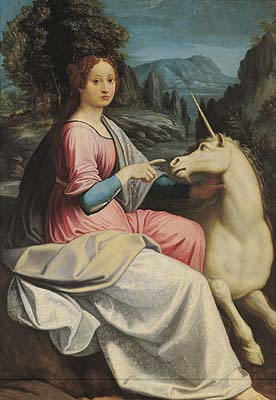Giulia Farnese (1474 – 23 March 1524) was mistress to Rodrigo Borgia (Pope Alexander VI).
She was known as Giulia la bella.
Lorenzo Pucci described her as "most lovely to behold."
Cesare Borgia, son of Rodrigo Borgia, described her as having dark colouring, black eyes, round face and a particular ardor.
Her parents were Pier Luigi Farnese, Signore di Montalto (1435–1487), and his wife Giovanna Caetani.
One earlier member of this dynasty had been Giovanni Farnese (Pope Boniface VIII (1294–1303)).
Giulia Farnese had four siblings.
Her oldest brother, Alessandro, was a notary who embarked on an ecclesiastical career.
Her second brother, Bartolomeo, became Lord of Montalto in Alessandro's place, married Iolanda Monaldeschi, and had issue.
The fourth sibling was a sister, Girolama.
On 21 May 1489, she married Orsino Orsini in Rome (the signing of the marriage contract had taken place the previous day).
Her dowry for the match was 3,000 gold florins (around US$500,000).
Orsini was the stepson
of the ambitious Adriana de Mila,
third cousin to Rodrigo Borgia,
Vice-Chancellor of the Church.
Orsini was described as being
squint-eyed and was devoid of
any meaningful self-confidence.
According to Maria Bellonci, it is uncertain when Rodrigo Borgia fell passionately in love with Giulia and decided to make her his mistress.
What is known is that Adriana de Mila, Borgia's cousin, eventually gave her approval in order to win a higher status for her son with the Vatican.
By November 1493, Giulia Farnese (Signora di Orsini) was living with Adriana de Mila and the Pope's daughter Lucrezia Borgia in a recently built palace next to the Vatican from where the Pope could easily make his clandestine visits.
The affair was widely known among the gossips of the time.
Giulia was referred to as "the Pope's whore" or sarcastically as "the bride of Christ" --
Giulia Farnese and Lucrezia Brgia became close friends.
Through her intimacy with the Pope, Giulia Farnese was able to get her brother Alessandro Farnese created Cardinal.
This earned him the title of "the Cardinal of the skirts" from Pasquino.
Giulia Farnese had a daughter whom she named Laura.
It is not clear whether Laura's father was Orsini or Rodrigo Borgia.
Maria Bellonci believes that there is evidence that she did have a physical relationship with her husband.
Whatever the case may be, Giulia Farnese claimed that Laura ("Borgia") was indeed
Rodrigo Borgia's daughter, but this
may have been to raise the status of the child
for future marriage considerations.
In 1494, she angered Rodrigo Borgia by setting off to Capodimonte to be at the deathbed of her brother Angelo.
She remained away from Rome, even after her brother's death, at the insistence of her husband ORSINI.
ORSINI eventually capitulated to papal pressure, however, and she soon set off on the journey back to Rodrigo Borgia.
This occurred at the same time as the French invasion of Italy under Charles VIII.
Giulia was captured by the French captain Yves d’Allegre, who demanded from the Pope, and received, a ransom of 3,000 scudi for her safe conduct to Rome.
Giulia remained the Pope's mistress until 1499 or 1500.
At this time, she seems to have fallen out of his favour due to her age.
Bellonci believes that the break between the two was probably made amicably with the help of Adriana de Mila.
Orsini also died around this time.
She then moved to Carbognano, which is not far from Rome.
This town had been given to Orsini by Rodrigo Borgia.
Rodrigo Borgia himself died three years later.
Giulia returned to Rome for the wedding of her daughter Laura Borgia in 1505.
Laura Borgia was married to Niccolò della Rovere, who was the son of the sister of then Pope Julius II.
For Giulia Farnese, her time of love was not over.
In the first years of her widowhood, after a series of lovers whose names have not been recorded, she married Giovanni Capece of Bozzuto.
He was a member of the lower ranking Neapolitan nobility.
In 1506, Giulia became the governor of Carbognano.
Giulia took up residence in the citadel of the castle.
Years later, her name was inscribed on its gate.
The chronicle of the castle states that Giulia was an able administrator who governed in a firm and energetic manner.
Giulia stayed in Carbognano until 1522.
She then returned to Rome.
She died there, in the house of her brother, Cardinal Alessandro.
She was 50 years old.
The cause of her death is unknown.
Ten years later her brother ascended the papal throne as Pope Paul III.
Laura and Niccolò had three sons, who inherited the possessions of the Orsini family.
References [edit]
| Wikimedia Commons has media related to: Giulia Farnese |
- ^ Gregorovius, Ferdinand Lucrezia Borgia according to Original Documents and Correspondence of her Day
Further reading [edit]
Patrizia Rosini, Danilo Romei (2012). " Regesto dei documenti di Giulia Farnese". ed. Lulu. ISBN 978129100120 Check
|isbn= value (help).
Bellonci, Maria. The Life and Times of Lucrezia Borgia.
del Vecchio, Edoardo (1972). I Farnese. Rome: Istituto di studi romani.
Spinosa, Antonio (1999). La saga dei Borgia. Milan: Mondadori. ISBN 88-04-48662-7.
|

No comments:
Post a Comment